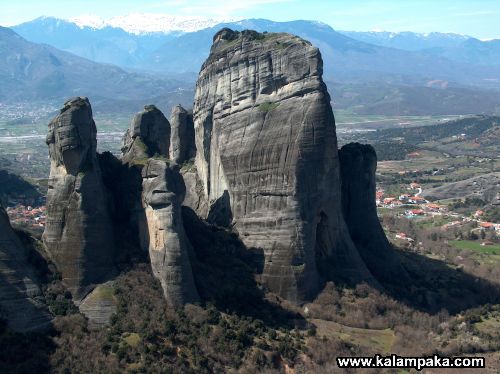In central Greece and particularly in the North Western part of Thessaly, between North East of Hasia and West of Pindos, where the plain of Thessaly ends, gigantic rocks raise (Meteora), that create a spectacle which might be unique worldwide.
No reference concerning these rocks exists, neither in mythology nor by some Greek or foreign historians.
Historians and geologists started to be interested in the creation of these rocks about 1000 years ago, expressing several theories.

The prevailing theory is that one of the German geologist Philipson, who came to Greece in the late 19th century. According to his theory, a large river had his estuary in this area which for million of years was covered by a narrow and deep part of the sea .The river waters place matter, stones and generally several materials that were transferred by its waters at the estuary from Northern parts of primordial central Europe. From the accumulation of these materials deltaic cones were formed.
25-30 million years ago, after some geological changes took place during the centuries, the central part of today’s Europe was lifted. That’s how the opening of Tempi was created ,having as a result the pouring of the waters in today’s Aegean sea.
During the tertiary period ,at the time of the alpine orogenies, the solid volumes of the “rocks” were cut off from the mountain chain of Pindos that was created and as the centuries went by, the plain of Pinios river was formed between them.
With the continuous corrosion by the wind and the rain as well as by other geological changes, these rocks took their present form through the passing of million of years.
At the cavities, fissures and peaks of the rocks, the people of that place found protection from the raids of several conquerors and of those who passed from the area.
Also, several bold hermits and anchorites found shelter at these rocks, seeking for mental calmness, tranquility and while praying they saught for Christian perfection.
In the beginning, the hermits were isolated and were praying in small chapels called “prosefhadia”(in Greek means places for pray) not only for their salvation but also for the salvation of all people. Their life was simple and the work painful.
The exact time that the rocks were inhabited is not known, but according to the existing scripts the monkhood is presented when already organized.
According to the Byzantinologists the first hermits must have taken refuge in the rocks at the end of the first millennium.
According to some information, Barnabas is mentioned as the first hermit at around 950-970 AD, who established the cloister of the Holy Ghost followed by the establishment of the cloister of the Transfiguration of Jesus by the monk Andronikos from Crete in the early 1000 AD. Later, at around 1150-1160 AD the Cloister of Stagi or Doupiani is established.
Except the aforementioned cloisters others also existed in several cavities around the rock of Doupiani, of Holy Ghost and the rock of “Sourloti”.
At the beginning of the 12th century, in the area of the Meteora a small ascetic state was formed which had as centre of worship the church of Mother of God, that was forming the “Kyriako” (church or temple) or the “Protato” (the first place) which is extant until today and is at the north part of the rock of Doupiani.
They were flowing to this small church from their hermitages in order to perform their common worship towards God, to discuss the several problems that concerned them and to ask for the help of other hermits in order to carry out the hard work.
The leading man of the cloister of Doupiani or cloister of Stagi had the title of the “first” and the one under the guidance of the Monastery of the Mother of God of Doupiani.
Almost 200 years later, in the middle of the 14th century (1340-1350 AD) the Holy Monastery of the Transfiguration of Jesus on the mount was established by Holy Athanasios, who gave to the big rock “Wide Stone” the name Meteoro and since then all the rocks have this name.
Later on, we have the creation of many Holy Monasteries in a period of 2 centuries (14th-15th), a time of great prosperity for the monkhood in the Meteora. Their number reaches 24.
In the middle of the 14th century monk Nilos, who is the founder and proprietor of the Holy Monastery of Ascension (the Holy Monastery of Ipapanti-Candle Mass- today) with very important Frescos, takes great action.
The first hermits climbed up the rocks by using scaffolds that they proped up to joists which where wedged in holes of the rock.
Later, they used rope ladders and net, until the first ladders were carved in the early 20th century.
As years went by and being under several difficulties of the times such as several conquerors of the area, thieves’ raids and other factors, many of the flourishing Holy Monasteries were driven to abandonment and destruction (the period of decline after the 17th century).
Today, the tradition of orthodoxy is continued uninterrupted for over 600 years by the Holy Monastery of the Great Meteoro or (the Transfiguration of Jesus on the mount), the Varlaam Monastery, the Saint Stephen Monastery, the Holy Trinity Monastery, the Saint Nicolas Anapafsas Monastery and the Roussano Monastery.
Furthermore, with the generous efforts of the monks, of the Bishop Serafim and the contribution of the state, of the European Union and of several citizens, many of the Holy Monasteries have been maintained and restored.
Also restored are: 1) the Saint Nicolas Badovas monastery (dependency of the Holy Trinity monastery) and 2) of Ipapanti-Candle Mass (dependency of the monastery of the Transfiguration or Great Meteoro).
